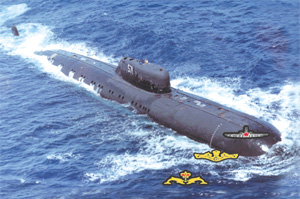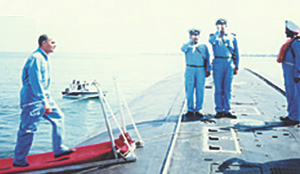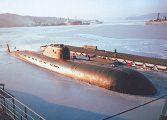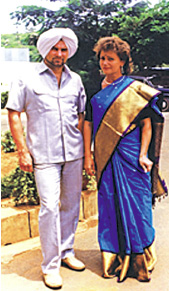| Tell a friend | Print version |
|---|
The Friendship Chakra
Alexander Ivanovich Terenov's book Under Three Flags: The Saga of the submarine
cruiser Chakra/K-43 is a story of the submarine- K-43 in the Soviet Navy and the
Chakra in the Indian Navy, which spent a small part of her chequered career flying the
Indian flag, and brought the Indian Navy into the exciting era of nuclear propulsion. The
story of the Russian Charlie class SSGN, has been told from a very personal point of
view, and because of this it becomes an engaging human narrative which never loosens
its grip on the reader's attention, says VAdm (Retd) R Ganesh who has translated the
book from russian to english. Salute (www.salute.co.in) presents the excerpts of the book in its original form.

They were looking for a submarine with tube-launched anti-ship and landattack missiles, but at that time we did not have weapons of this type. Evidently after that visit to the K-43 by the Indian delegation in August 1982 the final choice of the submarine was made. This was hardly surprising, as the appearance of this class of submarine in our Navy was an unpleasant surprise for the carrier and battle-group formations of NATO. Compact, and armed with the unique underwater-launched cruise Amethyst missile, this submarine certainly complicated life for the adversary. Its short time of flight, low trajectory and lethal radius made counter-measures difficult. The submarine needed no external target indication and was capable of attacks based on self-generated target data, which overcame other disadvantages, especially in restricted seas such as the Mediterranean or in confined waterways such as the Malacca or Gibraltar Straits. Even today, having more modern missiles, we experience difficulty in exploiting the advantage of their longer range because of the absence of target data. The Project 670 submarines were thus unique, especially in those years.

Rajiv Gandhi the first Indian to receive the submarine in outer harbour, boards the ship to announce the nuclear submarine era for the Indian Navy
On return to Kamchatka after completing the passage of the submarine I continued serving in the 10th Division, and in 1983 they appointed me in command of the K-43. (I learnt later that Captain 2nd Rank LZ Lupach was to have been nominated, but he was apparently wiser evidently he was better informed.) People have often asked me why I was particularly chosen for this assignment. I always reply with the old anecdote about the young lady of easy virtue, who when persistently asked how it was that she, a Philology graduate from the Moscow State University with honours in three foreign languages had become a highclass call-girl, breezily replied: "I guess I was just lucky"! Of course now I permit myself to laugh it off, after the assigned task has been successfully accomplished and the crew as well the submarine have inscribed a shining page in the history of our country's submarine fleet. But at the time I was in no mood to laugh, as the relocation from Kamchatka to Primorye, the prospect of a long period under refit and an uncertain future all took their toll on both my wife and me. The previous Commanding Officer NY Maryashin had already been appointed in the Operational Training Department of the Navy in Moscow and was packing his suitcases. Nikolai Yakovlevich was an experienced and a highly respected commander who had already finished five years in command of the K-43, and had navigated the submarine under the Arctic ice when she was transferred from the Northern to the Pacific Fleet. It was as I went through the process of taking over from him that I began to understand, with horror, the rashness of the enterprise that I had embarked on. The fact was that the majority of the crew hadn't been to sea for several years. The most knowledgeable of them stayed back in Kamchatka, and many of them had been drafted from submarines of other Projects under refit, apparently thinking that they were being sent on a vacation to the fabled land of India. The majority of officers and Warrant officers were marvellous people, honest and sincere. But, as they say, in the Navy there's no cadre such as "good fellow." We needed to be not only a good crew, but also instructors capable of training three professional Indian submarine crews, and perhaps, spend a few years in India.

Having assessed the situation and arrived at my decisions, I succeeded in getting an appointment with the C-in-C Pacific and informed him of my apprehensions and suggestions. Admiral VV Sidorov heard me out attentively, accepted all my proposals, and issued the necessary directives. Briefly, my proposals were that the crew was to be urgently augmented from the resources of the 10th Division and sent to the Training Centre at Obininsk for an inter-patrol refresher course, then to Kamchatka for acceptance of the next submarine in the line and completion of their work-up training tasks. After having passed all the work-up inspections and having qualified as an operational crew, I wanted them to be sent once again to to the Obininsk Training Centre for a month to study the specific features of this submarine after her major modifications. And only then should they be assigned for the acceptance of the submarine from the Dockyard, confirm her operational readiness and take on the training of foreign crews. The time allotted for all this was not more than eight months. I can't say that my plan was met with understanding by my officers and Warrant officers, especially those who had to fly back to Kamchatka. They were faced with a prolonged separation from their families, absence from their homes, and a colossal amount of work. But my sailors were happy at the prospect of the exciting trips to Moscow and Kamchatka, and the opportunity to be real submariners on an operational boat instead of rotting in a never-ending refit. Perhaps today I would not have taken that risky course, but then I had some experience and a lot of keenness, and most important of all, I was young and strong.

An amusing incident that happened that day. After sending the crew back to Ribachi, in Paratunka I met some hunters from Kamchatka. In a mellow mood after some dry wine in their company, I heard the moving story of how they had shot a bear and only later discovered her lair with two four-month old cubs inside. They took the cubs with them, realizing they would not survive without their mother. They proposed to rope me into their rescue plan for the cubs by presenting one of them to me. I don't know which had the greater effect on me the urge to support wildlife or the case of white wine which we had by this time emptied, but my instinct let me down, and I acquiesced to their plan. People often ask me about intuition and how it helps in life. My answer is that the head is used for thinking, and the seat of the pants is for sitting on; You shouldn't get the roles of these two ends mixed up - if you do, be prepared to look silly.

Singh is King: Captain Terenov with wife Mrs Tanya in Indian attire
I was wakened in my bunk early the next morning by my face being licked tenderly and covered with smacking kisses. In my half-asleep state I thought I was at home in bed with my wife, and my arm automatically reached out to embrace her and opened my eyes to see a shaggy, brown, impudent, hungry but altogether lovable bear cub, which was licking my ear and whispering erotic things in it. The painful memory of how I had got into this predicament came flooding back. I should mention that the cabin I was in had been "rented" to me by my old shipmate from the K-320, Boris Blednov, now the CO of K-201 and away on leave. In 1979 we had been together (he as ExO, and I as Captain's Assistant) on the K-320 during her under-ice transit from the Northern Fleet to Kamchatka. On a few occasions we had surfaced in a polinya, and played football on the pack ice, and scared off polar bears. He was an experienced CO, strict and fond of neatness and order in his cabin as much as on board his submarine. I benefited greatly from his advice on naval as well as everyday matters. I looked around the room and thought to myself that a bull in a china shop would have caused less havoc than this bear cub in the captain's cabin, and I would never be able to pay back Boris in this lifetime. Clearly Mishka was hungry; his intelligent doggy eyes spoke for him but other than beer I had nothing else, so he and I knocked back a can each. We both felt better at once, and began to understand one another. I recalled how the previous evening I chose one of the cubs and jumped into a pool (which had no water in it) where they were awaiting their fate. One of them tore off to the far corner, emitting a smelly jet of something behind him which I straightaway recognized as "bear sickness". The other showed no fear at all, but stood up on his hind legs and watched my actions attentively and with great suspicion. Then he winked at me - and that tilted the balance in his favour. I feinted with the left as advised by the tactics manual, and grabbed him by the scruff of the neck with my right hand (which neutralised his main advantage excellent reflexes and two-inch long claws.) and dumped him in a sack. These exertions were followed by another drink, and then one for the road, and another for the prize of the hunt. And somehow in the dead of night Mishka got free and "re-arranged" the cabin.
Soon the cub became the pet and mascot of the crew, and by a unit order he was given a ration allowance and was re-named Mashka, as he turned out to be a female! She weighed fifteen kilos, and her favourite treat was condensed milk, which she became a virtuoso at drinking straight from the jar. She would curl her tongue up in a tube and suck out the milk, then with one swirl of her tongue would leave the jar spotlessly clean. When the time came for our departure to Obininsk there was a huge gathering of people to see us off at the airfield. The Division Commander wished Mashka success in taking control of the bear population in the European part of the country and in improving their bloodline, and gave permission for the aeroplane to take off. Amazingly, she withstood the journey beautifully; she strolled across the tarmac, entered the spacious wooden crate that had been made for her, and neither the nine-hour flight nor the nine time zones we crossed had the slightest effect on her good spirits.
Extract of Under Three Flags: The Saga of the submarine cruiser Chakra /K-43
Of Sasha and Charlie class Chakra
Vice Adm (Retd) AK SINGH
(former Commander-in-Chief Eastern
Naval Command)
I first met the then "young and handsome"
32 year old Captain 3rd Rank
(Lieutenant Commander) Alexander
Ivanovich Terenov, over 25 years ago, in
1983, in Vladivostok, where we had arrived
for nuclear submarine training (1983 -1986)
to operate the Russian Charlie class
SSGN, K-43 (later to become INS Chakra
under a three year lease 1988-1991). Alexander,
liked to be called Sasha, and thats
how I have referred to him ever since. By
the time our 30 month training finished,
Sasha, had been promoted twice over, and
was Captain 1st Rank (equal to Captain of
the Indian Navy).
For some of the Indian crew, this was not our first visit to the former USSR, so we were quite aware that the average Soviet Navy submariner was a simple, friendly, hardworking, hard drinking professional, with a remarkable sense of humour. What makes this book particularly readable, apart from the 80 photographs in its 300 pages, is that its written by a former Soviet Navy submarine Captain, who saw the breakdown of the USSR, and the transition of the once mighty Soviet Navy, into a much smaller, Russian Navy, which is still a very potent force. Also, many Soviet Navy personnel came to India, but few wrote about their experiences with the Indian Navy in English. In the case of Sasha, his direct association with us was over 51/2 years (21/2 years in Vladivostok and three years in Vishakapatnam). I saw Sasha in action at sea in a closed nuclear submarine environment for weeks at a stretch, and must place on record, that he was truly very professional. I would hate to be target, if Sasha was carrying out a missile or torpedo attack against me!! In February 2001, as Eastern Fleet Commander, I was particpating with my Fleet, in India's first ever International Fleet Review (IFR) at Mumbai, where ships from many foreign navies also participated. Their were two destroyers from the Russian Pacific Fleet, who had come from from Vladivostok, under the command of Vice Admiral Alexander Vasilievich Konev (Deputy Commander-in-Chief, Pacific Fleet), who was a submariner. This Russian Admiral was very keen to meet me, so, after gettiing official permission, myself and a number of Indian submariners met the Russians at an official "beer and lunch" at the Submarine Base Complex, where the very emotional Russian Admiral presented me, the Depth gauge of INS Chakra. In true submarine fashion, we also exchanged our submarine badges, I took this Chakra souvenier to Vishakapatnam, and installed it (with a suitable brass plaque, recording its history) inside the Indian Navy Submarine Kursura "Submarine Museum", located on the beach. Many years later, after I had retired, Sasha (also retired) presented me a Russian language copy of his book, which is now translated into English, by Vice Admiral RN Ganesh (Retired). I vividly recall the various incidents mentioned by Sasha, since I was present, but being a thorough gentleman, he has omitted some truly awe inspiring anecdotes of "sauna, vodka and raw spirit". This book, is indeed a "must read" for all professional submariners and military personnel. The accompanying excerpts, give a glimpse, of a bygone era, of a fantastic period of interaction between the Indian and Soviet Navies. I wish you all happy reading!!



